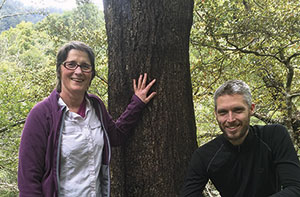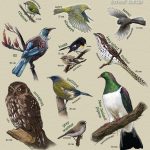Ideas for children, parents and teachers to explore and discover what lives in New Zealand’s native forests
for children
 The New Zealand bush is a unique place, and is home to our iconic kiwi and other world famous animals. It’s a great place to explore and discover wildlife. You might be surprised at how easy it is to find a piece of bush to explore – there are many reserves and parks in cities and towns that have patches of bush. Some of our wildlife can only live in sanctuaries. While these are often on islands, more and more sanctuaries are being created around New Zealand – find out if there is one near you.
The New Zealand bush is a unique place, and is home to our iconic kiwi and other world famous animals. It’s a great place to explore and discover wildlife. You might be surprised at how easy it is to find a piece of bush to explore – there are many reserves and parks in cities and towns that have patches of bush. Some of our wildlife can only live in sanctuaries. While these are often on islands, more and more sanctuaries are being created around New Zealand – find out if there is one near you.
In our book, we have chosen a few of the most common animals and plants that you will find, as well as those that live in sanctuaries. Ned has drawn pictures of them to help you recognise them and to show you where they live. Gillian has written about the animals so you can learn more about them. There is a card in the back of the book to help you identify birds in the bush.
staying safe in the bush
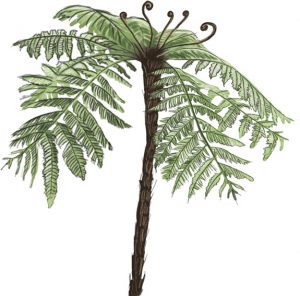 It is important to be prepared when going on a bush walk, even if it’s in a park that you know well. Here are some tips for keeping safe:
It is important to be prepared when going on a bush walk, even if it’s in a park that you know well. Here are some tips for keeping safe:
- Go with an adult and stay close to and in sight of them
- Leave pest traps and bait along
- Carry your own water, food and extra clothing
- Follow the Outdoor Safety Code
The Outdoor Safety Code is:
- Plan your trip
- Tell someone where you are going
- Be aware of the weather
- Know you and your children’s limits
- Take sufficient supplies
looking after the bush
The bush and the animals and plants that live there need us to take extra care of them. Things you can do to look after the bush include: carry out any rubbish, keep to pathways and tracks, take action to improve the bush ecosystem by joining in with planting or other conservation activities.
be a nature explorer
It’s easy to be a forest nature explorer. Here are some things you can do:
- Take a magnifying glass to look at what animals are living in the leaf litter, or to look more closely at plants.
- Take the card from the back of the book to help you identify birds. Remember, some birds are curious but others will be frightened by loud noises, so try creeping along quietly.
- Take binoculars to look up into the trees or to look at birds.
- A bird whistle will attract fantails.
- Try using all of your senses to observe what is around you. What do you hear if you close your eyes and everyone is quiet for five minutes?
for parents and teachers
 The New Zealand bush is an ecosystem that is home to some of the world’s unique wildlife. Many of the plants and animals in the bush are found nowhere else in the world. Here, children can learn:
The New Zealand bush is an ecosystem that is home to some of the world’s unique wildlife. Many of the plants and animals in the bush are found nowhere else in the world. Here, children can learn:
- That living things have different habitats, and have certain requirements to stay alive (for example, sunlight, shade, water, a way of hiding from predators, certain kinds of food)
- That there are important relationships between living things (for example, birds eat insects that were eating plants, fallen leaves create leaf litter which is home to many creatures)
- About changes caused by the different seasons, animal and plant life-cycles
- That people’s actions have an impact on the worlds’ biodiversity and affect the survival of unique species
At the same time they can be learning to think like scientists by:
- Developing their observation skills
- Thinking about how living things can be named and grouped
- Exploring and acting on issues
A note about the book
To simplify the layers of the bush for children, the understorey in In the Bush includes what is usually described as two levels e.g. undergrowth and sub-canopy, or shrub and sub-canopy. For a more detailed, but still child-friendly description of the bush go to: http://kcc.org.nz/
reading the book
Here are some ideas for re-reading the book, and things to look for and talk about and games to play:
- The imprint page (before the contents page) has the Outdoor Safety Code. Talk about keeping safe in the bush and why we need a safety code? What should we do to keep the bush safe? e.g. carry out your rubbish.
- Use the card from the back of the book to identify birds in the pictures as you turn the pages.
- If you have the hardback book, the endpapers have silhouettes of creatures and plants from the book. See if they can work out what they are.
- Pages 4–7 show a small tramping hut. Imagine you are staying in the hut – what would you hear at night? What would you take with you if you went to stay for the night?
- Pages 6–7 show the same scene as pages 4–5. Ask where the animals on pages 4–5 are at night, and where would the night creatures be hiding on pages 4–5 during the day time?
- Pages 6 and 14 both mention the noises birds make. Can they make the noises, i.e. imitate them?
- On page 11, the information box by the blue mushrooms say that this is picture on the $50 note. What animals and plants are pictured on all of our coins and notes? (You can find pictures online.)
- Page 15 shows the tall rimu that is then shown in detail on pages 16–17. Can they guess/remember what will be living in the tree before you turn the page?
- Page 20: ask what other pests and predators of wildlife the fence would keep out? e.g. pigs, deer, cats, dogs, hedgehogs
- Pages 26–29: birds often have many names in both English and Maori, the most common are listed on these pages. Many people are increasingly using Maori names for birds – do they know both (or even multiple names) for each bird?
- Page 35 suggests comparing the different barks of trees pictured in the book, some of the trees pictured, but not named, are a rimu on page 5 and a matai on page 9.
outdoor activities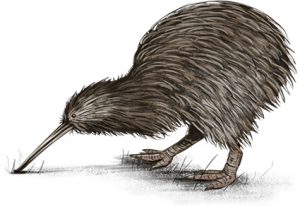
Before you go exploring on a bush walk:
- Make sure you follow the Outdoor Safety Code. See below for websites with more information about safety.
- If you are going in an area where there are kauri trees, make sure you follow advice about cleaning gear and not stepping on roots: kauridieback.co.nz/prevention
- Plan your activities to have as little impact on the bush as possible, carry out your rubbish, and if you are going into a reserve or protected area check rules about whether dogs are allowed, lighting fires, making sure your gear is clean, etc.
Learn more about the Outdoor Safety Code:
- www.mountainsafety.org.nz/Safety-Tips/
- www.doc.govt.nz/parks-and-recreation/know-before-you-go/safety-in-the-outdoors/
- www.adventuresmart.org.nz/land-adventures/
Useful things to take:
- magnifying glass
- binoculars
- bird whistle
- torch
- camera
- sun protection
- if you have a smart phone, there are several apps you can download to record/report sightings of animals
Many parks or reserves have nature trails set up, with signs to tell you about the trees, plants and animals there. These are good places to start if you want to learn more about what is in the bush.
Regional councils or parks often advertise free walks, activities or talks.
There are clubs for children to join, which run activities, such as the Kiwi Conservation Club, www.kcc.org.nz and Young Birders NZ http://youngbirdersnz.wix.com/youngbirdersnz
Kiwi Ranger is a Department of Conservation programme with booklets for children of activities specific to some national parks, reserves and sanctuaries: http://kiwiranger.org.nz
 Some tramping clubs run family tramps. This is a good way to learn about safety and bushcraft.
Some tramping clubs run family tramps. This is a good way to learn about safety and bushcraft.
There are many conservation projects aiming to protect this ecosystem, and there are lots of opportunities for families to get involved in these.
Nature Space is a website that lists projects: www.naturespace.org.nz
A list of sanctuaries can be found here: www.sanctuariesnz.org
Make nature walks purposeful by reporting sightings of rare birds or recording sightings of plants and animals on Nature Watch.
Take part in the annual Kereru Count: http://kererudiscovery.org.nz
Monitor tracking tunnels or look for signs of pests, see http://www.pestdetective.org.nz
Make nature walks fun by doing treasure or scavenger hunts, going on sound hunts, making clay or playdough prints of different tree barks, taking photos, practising bushcraft skills.
indoor activities and things to do at home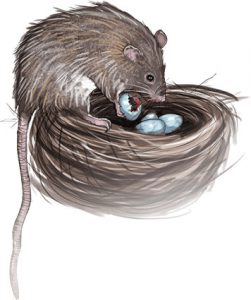
- Find out online about how to be a responsible pet owner, for example, how to prevent dogs killing kiwi
- Learn the songs of different birds. You can find bird songs on nzbirdsonline.org.nz, www.whatbird.co.nz, http://www.radionz.co.nz/collections/birds
- Keep a nature journal to record what you see on your trips
- Create your own field guide
- Join Nature Watch to share your photos and observations and have scientists help you with identification: www.naturewatch.org.nz
- Make a board game or card game based on the bush ecosystem
- Create a rain forest terrarium with ferns and other small plants and learn about the role of water in the ecosystem
- Find out how to make your garden a better habitat for native birds and animals
- Make muesli bars to take on your next bush walk
- Put together an outdoor survival kit
See Pinterest pages for more ideas for crafts and activities as well as information sources:
https://www.pinterest.com/gilliancandler/explore-nz-forests/
https://www.pinterest.com/gilliancandler/nature-walks-for-kiwi-kids/
Some useful and fun apps:
Nature Watch, Birdlife of New Zealand, Wildlife Tracker, Flora Finder, other apps that might be of interest are those which have mapping software
 more information about the bush
more information about the bush
There are many good field guides for adults, which children may also find easy to use. Try before you buy by getting them out of your local library first. Here are some websites with information and activities:
www.kcc.org.nz – Kiwi conservation club, quizzes and activities
www.teara.govt.nz – Te Ara – The Encyclopaedia of New Zealand, information
www.doc.govt.nz – Department of Conservation, information on native animals, plants, pests, as well as places to walk and ideas for parents and teachers
www.landcareresearch.co.nz – identification guides for animals, plants and fungi
www.nzbirdsonline.org.nz – New Zealand Birds Online, bird identification including bird song recordings
www.naturewatch.org.nz – Nature Watch, identification of living things, report your sightings and join projects
www.nzpcn.org.nz/ – NZ Plant Conservation Network, identification of plants
www.pestdetective.org.nz – Pest Detective, find out more about pests including their tracks and signs they leave behind
www.weedbusters.org.nz – Weedbusters, non-native weeds are a threat to the survival of the bush ecosystem
Species-specific sites – some are campaign or project based, there are also many Facebook pages devoted to specific species or causes
www.kiwisforkiwi.org – Kiwis for Kiwi
http://kakaporecovery.org.nz – Kakapo Recovery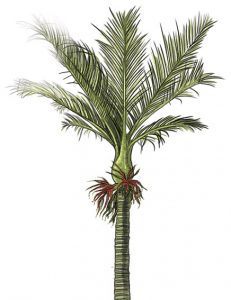
www.kokako.org.nz – Kaharoa Kokako Trust
www.hihiconservation.com – Hihi Conservation
www.nzfalcon.org.nz/ – New Zealand Falcon
www.mohua.co.nz – Mohua Charitable Trust
http://kererudiscovery.org.nz – Kereru Discovery
www.reptiles.org.nz – The NZ Herpetological Society
www.nzfrogs.org – NZ frogs
www.projectkahikatea.net.nz – Project kahikatea
www.kauridieback.co.nz/ – Keep Kauri Standing
www.nzepiphytenetwork.org – NZ Epiphyte Network
www.biol.canterbury.ac.nz/mistletoes/home.shtml – Mistletoe Research
curriculum links
Te Whariki
Strand 5: Exploration
Goal 4: Children experience an environment where they develop working theories for making sense of the natural, social, physical, and material worlds.
The New Zealand Curriculum: Science
Nature of Science
Investigating in Science, Communicating in Science, Participating and contributing
L1-2 Living World
Students will:
- recognise that living things have certain requirements so they can stay alive
- recognise that living things are suited to their particular habitat
- recognise that there are lots of different living things in the world and that they can be grouped in different ways.
L1-2 Planet Earth and Beyond
Students will:
- Explore and describe natural features and resources
- Describe how natural features are changed and resources affected by natural events and human actions.
Classroom resources
 For more information about the bush and for assessment and teaching ideas see:
For more information about the bush and for assessment and teaching ideas see:
www.sciencelearn.org.nz – Designed for primary schools, this site has lots of interactives, child-friendly explanations, videos of New Zealand scientists and other information. Contexts covered include: pollination, ferns, saving reptiles and amphibians, hidden taonga; science stories include: conserving native birds.
Building Science Concepts series: Book 3 Birds: structure, function and adaptation; Book 5: Fur, Feathers, and Bark: Animal and Plant Coverings; Book 6 Soil animals: diversity beneath our feet; Book 7: The Bush: Classifying Forest Plants; Book 25 Flowers, fruits and seeds: plants and their reproductive parts; Book 35 Is this a Plant?: introducing the plant kingdom; Book 62 Spiders everywhere!: silk spinning carnivores in our world; all published by the Ministry of Education.
http://scienceonline.tki.org.nz/Nature-of-science/Nature-of-Science-Teaching-Activities/Which-ones-are-spiders – difference between insects and spiders
www.doc.govt.nz/getting-involved/for-teachers/ for field trip ideas and resources
gillian candler – author
The bush is one of my favourite places. There is a lot to see if you know where to look. I started looking at what was on the ground as I walked along, and was amazed by the different coloured fungi, by the tiny orchids and hen and chicken ferns. I also like to stop and look up at the hanging gardens of epiphytes and wonder about what tiny creatures are living up there. I like to visit sanctuaries and see rare birds. One of my favourite memories is seeing Sirocco, the kakapo, when he came to Wellington. Every time I go for a bush walk I learn something new. I write a blog about nature: explorediscovernature.blogspot.co.nz
ned barraud – illustrator
I have always loved New Zealand’s bush. It is a magical place full of rare and unique creatures and plants. Some of my earliest memories are of donning a pack and going on tramping trips with my family into spectacular forest around Nelson. Now I take my own children into the forests around Wellington and we listen and look out for the creatures you will find in this book!
If you want to see some of my other pictures you can visit my site: www.nedbarraud.com




